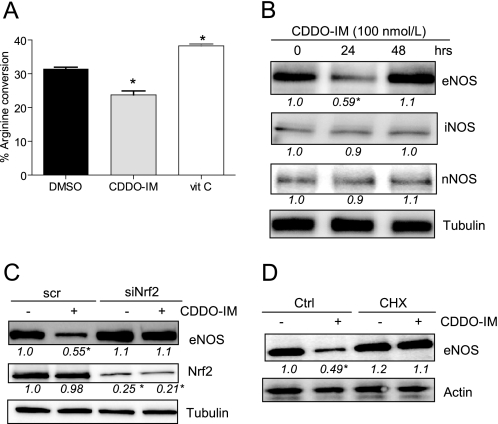FIGURE 3.
Activation of Nrf2 and de novo protein synthesis reduce eNOS enzymatic activity and eNOS expression. A, confluent HUVEC were treated with DMSO, 100 nmol/liter CDDO-IM, or 100 μmol/liter vitamin C (vit C; positive control) for 24 h and then subjected to an arginine-citrulline conversion assay as described under “Experimental Procedures.” The bar graph depicts the compilation of three independent experiments (* p < 0.05; n = 3; ANOVA, Dunnett's post test versus DMSO control; error bars indicate S.E.). B, HUVEC were treated with 100 nmol/liter CDDO-IM for the indicated periods of time before total cell lysates were subjected to a Western blot analysis for eNOS, iNOS, nNOS, and tubulin. C, HUVEC were transfected with scrambled siRNA (scr) and siRNA targeted against Nrf2 (siNrf2), respectively. 48 h later, they were exposed to DMSO (−) or 100 nmol/liter CDDO-IM (+) for another 24 h before total cell lysates were subjected to Western blot analysis for eNOS, Nrf2, and tubulin. D, HUVEC were pretreated with cycloheximide (CHX; 5 μg/ml) for 30 min and then exposed to DMSO (−) or 100 nmol/liter CDDO-IM (+) for 24 h. Immunoblot analysis for eNOS and tubulin were performed. Blots depict examples from at least three independent experiments showing consistent results. The numbers below the blots depict mean densitometric arbitrary units (ratio protein/loading control as -fold DMSO control) of all performed experiments (* p < 0.05, ANOVA, Dunnett's post test versus control (Ctrl).

